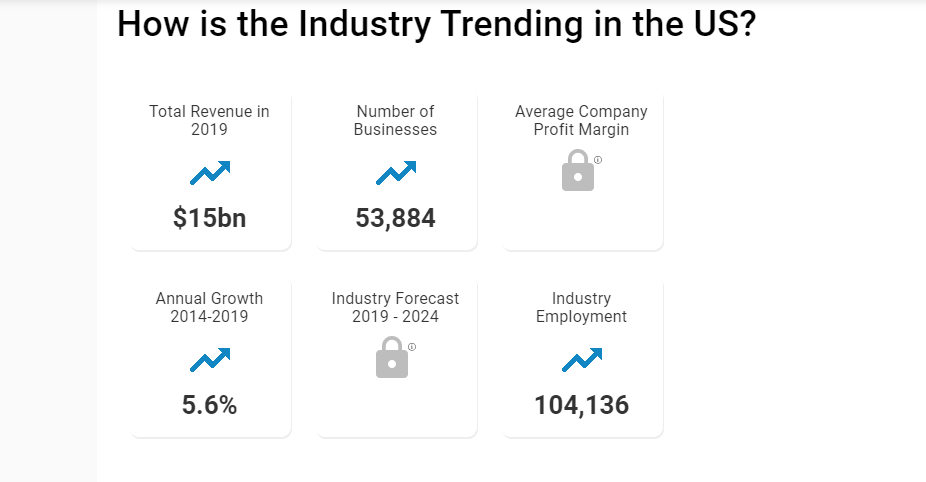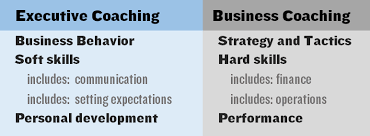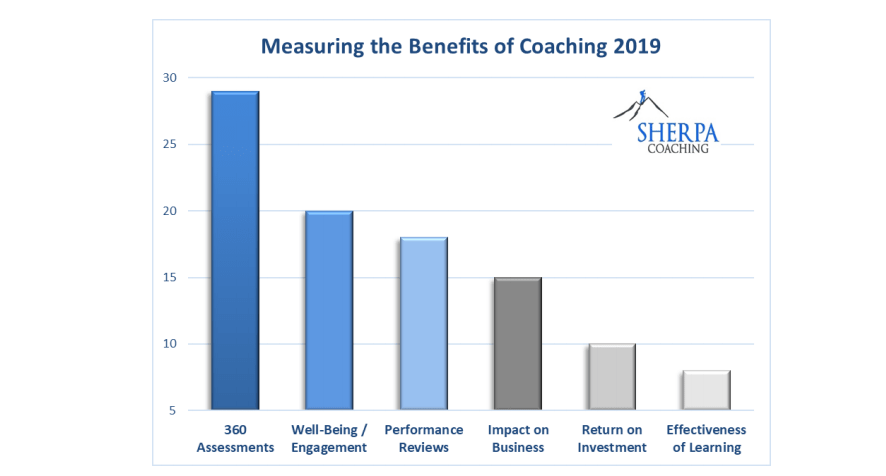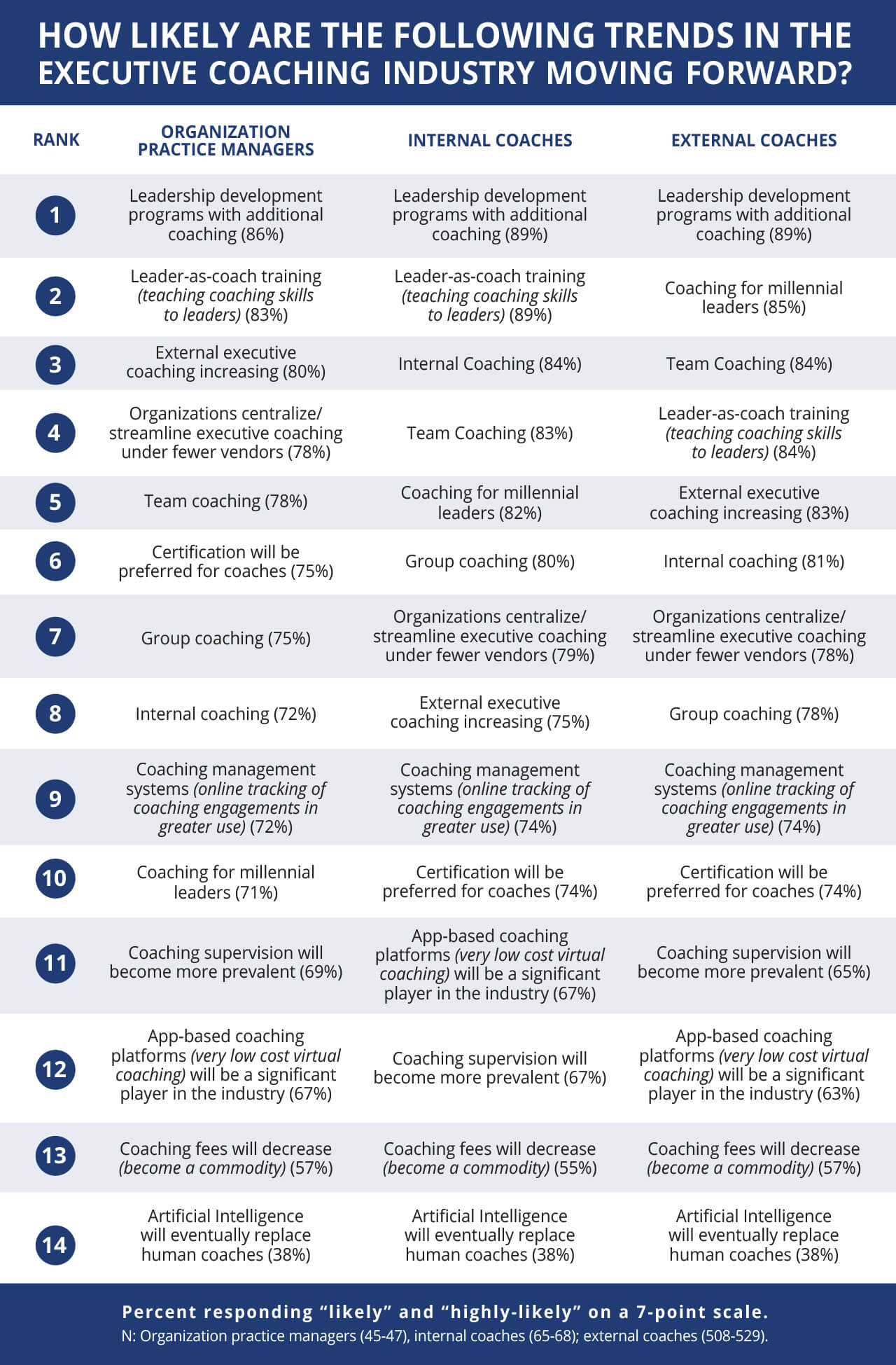Business Coaching Industry to top $15 billion in 2019
In this article:
- Global Coaching Industry Statistics for 2019
- 3 fast-growing niches for business coaches
- Executive coaching vs Business coaching
- Executive coaching 2022: future trends
- Coaching and Technology
- 2 Threats and 2 Opportunities
- 6 methods of measuring the benefits of coaching in 2019
IBISWorld estimates the business coaching industry revenue increased to $15 billion in 2019 at an annualized rate of 5.6%. In 2015, the estimated global revenue from coaching was $2.356 billion.

Source: ibisworld.com
Global Coaching Industry Statistics
Here are the main findings of the 2016 Global Coaching Study commissioned by the International Coaching Federation:
- Total number of coaches worldwide: approximately 53,300 professional coach practitioners;
- Total revenue generated worldwide from coaching in 2015 was $2.356 billion, representing a 19% increase over the 2011 estimate published in the 2012 ICF Global Coaching Study;
- The annual average revenue generated by coaching is $51,000;
- An active coach practitioner maintains an average of 11 clients at any given time;
- 67% of global coach practitioners are women, with the highest concentrations in North America, Eastern Europe and Oceania;
- 6% of coach practitioners are under the age of 35, with the largest numbers being in Eastern Europe (17%), Latin America and the Caribbean (11%) and Asia (9%);
- 54% of global clients are women.
1. Women empowerment coach
A women’s empowerment coach facilitates women to disengage from limiting beliefs and conditioned responses.
Women are looking to open up life choices that were previously inaccessible to them. Motherhood is no longer their sole legacy in life. They seek self-actualization and finding their unique purpose in life.
2. Employee satisfaction coach
Employee happiness and satisfaction is essential for business success and employers are aware of that. Employees want more than a higher paycheck.
The job of an employee satisfaction coach is to heal broken relationships within the workforce. Mostly it is about the employee’s relationship with themselves and their motivations within the team.
3. Sales coach
Sales coaches establish a longer and more frequent relationship with sales representatives than traditional sales training.
Their purpose is to ensure sales reps perform at their peak and bring in accounts to hit their quotas.
Executive coaching v Business coaching
In its 2019 Executive Coaching Survey, Sherpa Coaching defines executive coaching as “regular meetings between a leader and a trained facilitator, designed to produce positive changes in business behaviour in a limited time frame.”
Don’t confuse executive coaching with business coaching!
Business coaching is different from executive coaching in that it entails working to develop the client’s knowledge and skills.

Source: sherpacoaching.com
Hourly earnings: Global figures for 2019 via Sherpa Coaching
Executive Coaches: $398 per hour, up from $386 last year and $352 in 2017.
Business Coaches: $251 per hour, down from last year’s average of $279.
Life Coaches: $208 per hour, an increase over last year at $190 per hour.
Source: coachfederation.org
Executive Coaching 2022: Future Trends
- Coaching will become a commodity and fees will decrease (57%);
- Professional coaching for Millennials leaders will increase (82%). In total, 23% of coach practitioners surveyed reported their clients are under the age of 35.4;
- App-based coaching platforms will become a significant player in the industry (67%);
- Leader-as-coach training will become more prevalent (89%);
- Team coaching will increase (83%);
- Leadership development programs will include additional coaching (89%);
- More than half of coach practitioners (51%) believe to a large extent that coaching is able to influence social change.
Learn more: How coaching your team makes you a better leader
Coaching and Technology
Technology is always changing and the way coaches deliver services will change to reflect it.
In 2012, 45% of coaches delivered their services in in-person meetings.
In 2019, this percentage decreased to 32% while web video, Skype etc increased from 15% to 25%.
Today coaches use the telephone as a delivery method the same as in 2012: 25%.
Threats and Opportunities
There are two identified obstacles for coaching:
- Untrained individuals calling themselves coaches;
- The marketplace confusion about the benefits of coaching.
The main opportunities for coaching as identified by coach practitioners are:
- Increased awareness of the benefits of coaching;
- The emergence of credible data on the ROI/ROE from coaching.
Measuring the benefits of coaching in 2019
Measuring the benefits of coaching as accurate as possible is driving the growth of the industry.
Here are 6 methods coaches are using to show the value of coaching:
- 360 Assessments (which is a before-and-after method pioneered by Marshall Goldsmith) (29%);
- Well-being and Engagement (20%);
- Performance Reviews (18%);
- Impact on Business (15%);
- Return on Investment (10%);
- Effectiveness of Learning (8%).

Are you going to include coaching in your leadership development programs?
Join the Conversation
We’d love to hear what you have to say.
Get in touch with us on Facebook Group and Twitter.

How Coaching Your Team Makes You A Better Leader
Do you want to become a better leader? Read on to learn how coaching helped Stela Toderascu become a better leader for her team.
The Leader as a Coach
The day you become a manager, besides not having leadership training or a proper introduction to your new role, you also face a shock when you need to coordinate, inspire and develop a team of people who should completely trust you as their new leader.
It’s not a given that a brilliant specialist becomes a great leader. In the leadership position, it is more about the EQ than the IQ, and that makes a big difference.
Before you are a leader success is all about growing yourself. When you become a leader, success is all about growing others.
Jack Welch
Like many leaders, I had the opportunity to go through leadership training only several months after having been appointed department manager. You know that look in the eyes of your team when you get back from training and you start implementing the things you’ve just learnt. You can almost hear them say “ok, she went to another training and now she will try new things on us” 🙂

Leadership through coaching can be discouraging
Coaching-facilitated leadership can sometimes be discouraging. At the same time if you feel those new things can make positive changes, don’t hesitate to use what you’ve learnt.
[bctt tweet=”Stela Toderascu: Coaching brings out the best in people, saves time and drives long term results by creating a learning organization.” username=”brand_minds”]
In order to avoid awkwardness, just be sincere with your team and tell them what you are planning on doing with that info. Let them know how it will help each team member, and that you would be happy if they would be open to trying those new things, keeping the door open for any type of feedback. I really believe that being sincere is the most important thing when we talk about bringing the team on the same page.
The growth and development of people is the highest calling of leadership.
Harvey S. Firestone
A few months into my new managerial role, when I felt confident regarding my functional knowledge, the skill I was really proud of was that I could quickly find a solution for any type of problem. Also, when asking me for advice, each member of my team would get at least one solution in a very short period of time.
I was really proud of this skill until the moment I realized that what I was doing was totally wrong. Even if things moved faster and I felt empowered, it was not helping my team to think, develop and take the next step.
How coaching made me a better leader for my team
After new training, this time on how coaching can improve my leadership skills, I understood how important it was to involve team members in the solution-finding process and in reaching a final decision. It’s only in this case that they can learn, grow, feel engaged and accountable.
Of course, it was a big change for my team when instead of giving solutions I began asking them open questions. Nevertheless, progress became visible quite rapidly.
The biggest benefit for the team was the fact that they would develop new competencies all by themselves achieving autonomy and ownership in a short period of time.
Coaching brings out the best in people, saves time and drives long term results by creating a learning organization.
It was after implementing a coaching leadership style that I could easily identify my successors or the true talents that could become team leaders or get new roles in the company in a short period of time.

5 barriers to leadership through coaching
Leadership through coaching is not as easy as it sounds. I identified the following 5 barriers:
- When the relationship between manager and employee lacks trust;
- The personal style of the manager;
- When the employee doesn’t help the coaching process;
- The manager’s “ego”;
- Manager’s constant need for control.
In order to have a functional coaching relationship at work the manager should be a good active listener, should constantly give feedback, and ask open questions.
A manager with good coaching skills will always respect the differences between people and be confident in what he is doing by showing his confidence in coaching.
Another important factor of successful leadership through coaching is giving up full control and refraining from giving solutions even if they come to your mind every time an employee is telling you about an issue. In light of the above, some leaders also need coaching .
What is the recipe for coaching-facilitated leadership?
Set goals, promote discovery, perform active listening and encourage the employee to get to a minimum one solution and a plan to achieve that particular goal by asking open powerful questions.
Don’t forget to let people grow based on their own potential and don’t make them a copy of you.
Stela Toderascu
If you are curious about your leadership style you can take this 5-minute quiz.
Join the Conversation
We’d love to hear what you have to say.
Get in touch with us on Facebook Group and Twitter.
This App Supports Your Employee’s Emotional Wellness

Is your employees’ emotional wellness a topic of interest in your organisation? Read on to learn of an app which supports the emotional wellness of your employees.
According to the World Health Organization, mental disorders affect one in four people.
Experts estimate around 450 million people currently suffer from such conditions, placing mental disorders among the leading causes of ill-health and disability worldwide.
People suffering from mental disorders are difficult to diagnose and treat because of the negative perceptions about mental illnesses or mental conditions: stigma, shame, discrimination.
Learn more: Along the Road to Great Mental Health: Debunking the Myths & Stigma
While various studies have found mobile phones can have a negative impact on our physical and mental health, we can also find ways to use them to our benefit.
Our mobiles phones act as our windows into the world. But just as our mobile phones provide us with the latest political news, fashion trends or cake recipes, they also provide us with important insights into our emotional health.

A world where mental health is never an obstacle.
The team behind Ginger built the app on this very idea: that our interactions with our mobile phones can be turned into data which could supply an accurate and update emotional profile.

What is Ginger.io?
Ginger.io is an app which offers professional coaching services to support employees’ emotional wellness.
Mission
At the moment of need, we provide stigma-free access to high-quality coaches, clinicians and content. We’re coupling data science and virtual care to reinvent how the world gets mental health support.
About Ginger.io:
- It is a behavioural analytics platform which turns mobile data into health insights;
- The app is available to individuals whose employer or health plan offers Ginger as a benefit;
- It offers emotional-health coaching and therapy via chat, teletherapy and telepsychiatry via video;
- Ginger members can chat directly with a coach within the app at any time of day, 365 days a year;
- Ginger coaches are licensed therapists and certified psychologists; their expertise is focused on stress reduction, motivation, and human behaviour;
- With the help of the app’s coaches, members identify distorted thoughts, change problematic behaviours, tolerate painful emotions, successfully manage effects.
Benefits:
- On-demand 24/7 emotional support: Ginger members have immediate access to video sessions with therapists and psychiatrists;
- AI technology: AI technology helps the app’s clinical team reach out at times that are most helpful;
- Higher engaging rates than EAPs (Employee Assistance Programme): 8-30% employees engage with the app while EAPs see only 0-3% engagement rates at the same companies;
- Treatments: emotional-health coaching, mindfulness, cognitive behavioural therapy, and talk therapy;
- Alerts: the app provides alerts when user behaviour deviates from the norm.
Join the Conversation
We’d love to hear what you have to say.
Get in touch with us on Facebook Group and Twitter.

